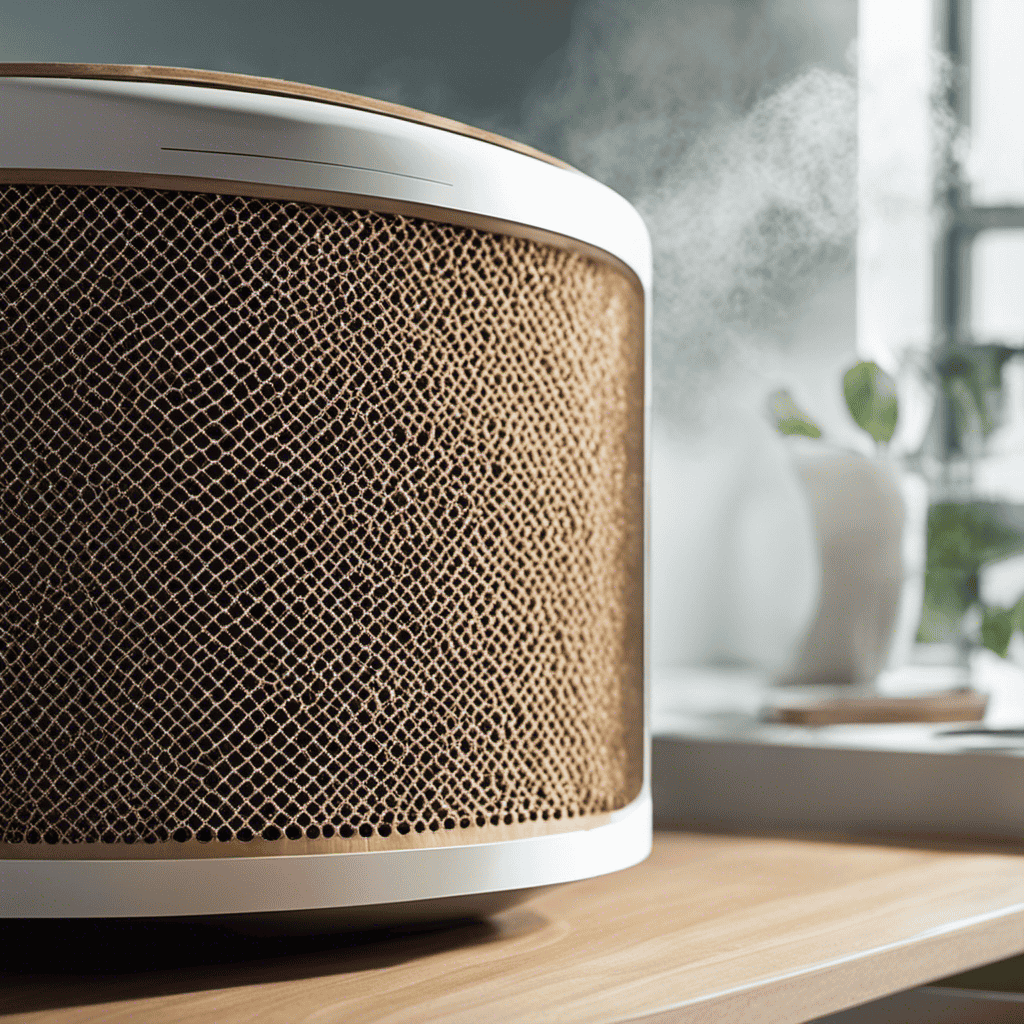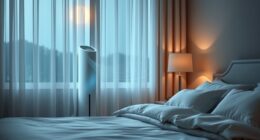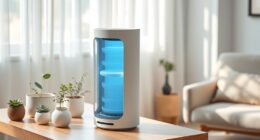I’ve been feeling better ever since I discovered the proper way to clean my Holmes air purifier. It’s surprising to see how much dust and dirt can build up in those filters over time.
In this article, I’ll guide you through the step-by-step process of cleaning your Holmes air purifier, ensuring that it functions at its best. From gathering the necessary supplies to reassembling the purifier, I’ll provide you with the detailed instructions you need to keep your air clean and fresh.
Key Takeaways
- Unplug the air purifier before cleaning to prioritize safety and prevent accidents or electrical shocks.
- Use a soft cloth or sponge, mild detergent, and warm water to clean the exterior of the purifier and avoid using harsh chemicals or abrasive materials.
- Clean the filters every 3 to 6 months for optimal performance and rinse and air dry the pre-filter before reinstalling.
- Gently remove the control panel cover and use a soft, lint-free cloth with mild cleaner to clean the control panel and buttons, ensuring it is completely dry before reassembling.
Gather the Necessary Cleaning Supplies
Before you can start cleaning your Holmes air purifier, you’ll need to gather the necessary cleaning supplies.
It is important to take safety precautions while cleaning the air purifier to avoid any accidents or damage. The first step is to unplug the device from the power source to ensure your safety.
The cleaning supplies you will need include a soft cloth or sponge, mild detergent, and warm water. It is essential to use proper cleaning techniques to maintain the efficiency and functionality of your air purifier.
Start by wiping down the exterior of the device with a damp cloth. For the filters, gently remove them and rinse under running water. Avoid using harsh chemicals or abrasive materials as they can damage the filters.
Once all the components are clean and dry, reassemble the air purifier and plug it back in. Following these steps will help keep your Holmes air purifier in top condition and ensure clean air in your space.
Turn off and Unplug the Air Purifier
When it comes to cleaning an air purifier, it is important to prioritize safety precautions. This includes ensuring that the unit is turned off and unplugged before beginning any cleaning procedures.
Additionally, proper cleaning techniques should be followed to effectively remove dirt, dust, and debris from the purifier’s components.
Lastly, the frequency of cleaning required will vary depending on the specific model and usage, but generally, it is recommended to clean the air purifier every few weeks or as needed to maintain optimal performance.
Safety Precautions While Cleaning
To ensure your safety while cleaning your Holmes air purifier, make sure to unplug it from the electrical outlet before starting. Safety measures are essential to prevent any accidents or electrical shocks.
When cleaning the air purifier, it is important to use the right cleaning equipment. Start by using a soft, lint-free cloth or a microfiber cloth to wipe down the exterior of the purifier. Avoid using harsh chemicals or abrasive materials that may damage the surface.
For the filters, carefully remove them and gently tap them to remove any loose debris. It is recommended to vacuum the filters to remove any trapped dust or particles.
Remember to follow the manufacturer’s instructions for cleaning and maintenance to ensure optimal performance and longevity of your Holmes air purifier.
Proper Cleaning Techniques
Make sure you use a soft cloth to wipe down the exterior of your air purifier, avoiding any harsh chemicals that could damage the surface. Here are some proper cleaning techniques to keep your Holmes air purifier running smoothly:
- Start by unplugging the unit and removing the filters.
- Gently vacuum the pre-filter to remove any large particles.
- Use mild soap and water to clean the pre-filter, gently scrubbing with a soft brush if needed.
- Rinse the pre-filter thoroughly and allow it to air dry completely before reinstalling.
- For the HEPA filter, check the manufacturer’s instructions for specific cleaning recommendations.
- Wipe the exterior of the unit with a damp cloth to remove dust and dirt.
- Finally, reassemble the filters and plug the unit back in.
Following these safety precautions and maintenance tips will help ensure the longevity and effectiveness of your air purifier.
Now, let’s discuss the frequency of cleaning required.
Frequency of Cleaning Required
Regularly maintaining your air purifier is essential for optimal performance and longevity. By cleaning your air purifier regularly, you can ensure that it continues to effectively remove airborne pollutants and allergens from your indoor air. The frequency of cleaning will depend on several factors, such as the manufacturer’s recommendations and the air quality in your home. However, as a general rule, it is recommended to clean the filters of your air purifier every 3 to 6 months. This will help prevent the accumulation of dust and debris, which can hinder the purifier’s performance. Regular maintenance also has several benefits, including improved air quality, increased energy efficiency, and prolonged lifespan of your air purifier. By incorporating regular cleaning into your routine, you can enjoy cleaner and healthier indoor air.
| Frequency of Cleaning | Benefits of Regular Maintenance |
|---|---|
| Every 3 to 6 months | – Improved air quality |
| – Increased energy efficiency | |
| – Prolonged lifespan |
Remove the Filters From the Air Purifier
First, check if there is a latch or release button to remove the filters from the Holmes air purifier. This step is crucial to ensure a proper cleaning process.
Once you locate the latch or release button, follow these steps to remove the filters:
- Gently press the latch or release button to unlock the filter compartment.
- Carefully pull the filters out of the purifier, making sure not to damage them.
- Take note of the type of filters you are removing, as different filters require different cleaning methods.
Proper cleaning frequency is essential to maintaining the filters’ effectiveness. Regularly check the filters for dirt and debris accumulation. Depending on the air quality and usage, it is recommended to clean or replace the filters every 3 to 6 months. Neglecting regular maintenance can lead to reduced air purifying performance and potential damage to the purifier.
Vacuum the Pre-Filter
After you’ve removed the filters, gently vacuum the pre-filter to remove any dust or debris. The pre-filter is an essential part of your Holmes air purifier and requires regular maintenance to ensure optimal performance. By vacuuming the pre-filter, you can effectively remove any trapped particles and prolong the lifespan of the filter.
To do this, follow these steps:
- Switch off the air purifier and unplug it from the power source.
- Locate the pre-filter at the front or back of the unit.
- Use a vacuum cleaner with a soft brush attachment to gently remove dust and debris from the pre-filter.
- Move the attachment back and forth over the pre-filter, covering the entire surface area.
- Pay extra attention to any heavily soiled areas or stubborn debris.
- After vacuuming, check the pre-filter for any remaining dirt or debris.
- If necessary, repeat the process until the pre-filter is clean.
- Once the pre-filter is clean, reassemble the air purifier and turn it back on.
Regular vacuum maintenance of the pre-filter is crucial for optimal performance and clean indoor air. Make sure to incorporate this step into your air purifier cleaning routine to keep your unit functioning at its best.
Clean the HEPA Filter
To maintain optimal performance, you should regularly vacuum the HEPA filter of your Holmes air purifier. This will remove trapped particles and prolong its lifespan. The HEPA filter is a crucial component of the air purifier. It captures 99.97% of airborne particles, including dust, pollen, pet dander, and mold spores.
Here are some important steps to properly clean and maintain your HEPA filter:
- Turn off and unplug the air purifier.
- Remove the filter from the unit according to the manufacturer’s instructions.
- Gently tap the filter to remove loose debris.
- Attach the brush attachment to your vacuum cleaner and gently vacuum the surface of the filter.
- Pay special attention to the pleats and folds of the filter to ensure thorough cleaning.
- Avoid using water or any cleaning agents on the filter, as it may damage the delicate fibers.
- Once the filter is clean and dry, reinsert it back into the air purifier and secure it properly.
Wash or Replace the Carbon Filter
When it comes to maintaining optimal air quality in your home, understanding the filter replacement frequency is crucial. Filters play a vital role in trapping and removing air pollutants, but they can become clogged over time.
Filter Replacement Frequency
You should check the filter replacement frequency of your Holmes air purifier to ensure optimal performance. Regular maintenance and replacing the filter on schedule is crucial for the effectiveness of your air purifier.
Here are the benefits of regular maintenance and following a filter replacement schedule:
-
Improved Air Quality: Regularly replacing the filter ensures that your air purifier continues to effectively remove pollutants from the air, keeping it clean and fresh.
-
Extended Lifespan: By adhering to the recommended filter replacement schedule, you can prolong the lifespan of your air purifier. This helps you get the most out of your investment.
-
Energy Efficiency: A clean filter allows the air purifier to operate efficiently, saving energy and reducing your electricity costs.
Cleaning Methods for Filters
Regularly maintaining and replacing the filters is essential for keeping your Holmes air purifier operating efficiently. Cleaning the filters can help improve the air quality in your home and prolong the lifespan of your purifier. However, it’s important to follow some safety tips and avoid common cleaning mistakes to ensure the best results.
Here are some safety tips to keep in mind when cleaning your Holmes air purifier filters:
- Always unplug the purifier before cleaning to avoid electric shock.
- Handle the filters with care to prevent damage or tearing.
- Use mild soap and water to clean the filters, avoiding harsh chemicals.
- Allow the filters to completely dry before reinstalling them.
Wipe Down the Exterior of the Air Purifier
To clean your Holmes air purifier, start by wiping down the exterior with a soft cloth to remove any dust or dirt. After wiping down the exterior, you can move on to the next step in air purifier maintenance.
Here are some cleaning tips to ensure your air purifier continues to function effectively:
- Use a vacuum cleaner with a brush attachment to remove dust and debris from the air intake vents.
- Clean the pre-filter regularly by rinsing it with water and allowing it to air dry completely before reinstalling.
- For the main HEPA filter, follow the manufacturer’s instructions for cleaning or replacing. Some filters can be vacuumed or washed, while others may need to be replaced entirely.
Clean the Control Panel and Buttons
When it comes to maintaining the performance and functionality of an air purifier, it is essential to regularly clean the control panel and buttons.
The control panel is the central hub for operating the air purifier and ensuring that it functions optimally. By cleaning the control panel and buttons, you can remove dust, dirt, and debris that may accumulate over time and potentially affect the functionality of the buttons.
Cleaning the Control Panel
First, make sure you unplug the air purifier before cleaning the control panel.
To properly maintain control panel functionality and ensure a deep clean, follow these steps:
-
Remove the control panel: Gently pry off the control panel cover using a small flathead screwdriver. Take care not to damage any wires or components.
-
Clean the control panel: Use a soft, lint-free cloth dampened with a mild, non-abrasive cleaner. Wipe the control panel and buttons, removing any dirt or grime. Avoid using excessive moisture to prevent damage.
-
Dry the control panel: After cleaning, use a clean, dry cloth to ensure the control panel is completely dry before reassembling.
-
Reassemble the control panel: Carefully snap the control panel cover back into place, making sure it is secure.
Maintaining Button Functionality
To ensure the buttons on your control panel continue to function properly, regularly inspect them for any dirt or debris that may be affecting their performance. Cleaning and maintaining your buttons is an essential part of button maintenance. Here are some troubleshooting tips to help you keep your control panel in top shape:
| Problem | Solution |
|---|---|
| Sticky buttons | Use a cotton swab dipped in rubbing alcohol to clean them. |
| Unresponsive buttons | Check the connection between the control panel and the main unit. |
| Loose buttons | Tighten the screws that hold the buttons in place. |
Remember to always disconnect the power before performing any maintenance. By following these simple steps, you can ensure that your control panel buttons remain in good condition and your air purifier continues to operate smoothly.
Clean the Air Intake Vents
Make sure you’re careful not to damage the air intake vents while cleaning your Holmes air purifier. These vents are crucial for the proper functioning of the device, as they allow air to be drawn in and purified.
To effectively clean the air intake vents, you will need the following cleaning tools:
-
Soft brush: Use a soft-bristle brush to gently remove any dust or debris that may have accumulated on the vents.
-
Compressed air: A can of compressed air can be used to blow away any stubborn dirt or particles that cannot be removed with a brush.
-
Damp cloth: Use a damp cloth to wipe down the vents and remove any remaining dirt or grime.
Troubleshooting tips for cleaning the air intake vents:
-
Ensure the purifier is turned off and unplugged before cleaning.
-
Avoid using excessive force or harsh cleaning agents.
-
Take extra care around delicate components.
By properly cleaning the air intake vents, you can ensure that your Holmes air purifier continues to provide clean and fresh air for your space.
Now, let’s move on to the next section where we will discuss how to clean the air outlet vents.
Clean the Air Outlet Vents
Now, let’s see how important it is to regularly clean the air outlet vents of your device.
The air outlet vents play a crucial role in ensuring that clean air is circulated throughout your space. Over time, these vents can become clogged with dust, pet dander, and other airborne particles, reducing the efficiency of your air purifier.
To clean the air outlet vents, start by unplugging the device and removing the front grille. Use a soft brush attachment on your vacuum cleaner to gently remove any accumulated debris. For stubborn dirt, you can use a damp cloth or cotton swab to carefully wipe the vents. Remember to be gentle and avoid using excessive force.
By regularly cleaning the air outlet vents, you can ensure that your air purifier continues to function optimally and provide you with clean and fresh air.
Now, let’s move on to the next section where we will discuss how to disinfect the air purifier.
Disinfect the Air Purifier
Regularly cleaning the air outlet vents is essential for maintaining the efficiency of your air purifier and ensuring that clean air is circulated throughout your space.
However, it is also important to disinfect your air purifier to eliminate any potential bacteria or viruses that may be present.
Here are some disinfectant options and cleaning tips to help you keep your air purifier in top condition:
-
Use a disinfectant spray or wipes specifically designed for electronic devices. These products are safe to use on the surface of your air purifier and can effectively kill germs.
-
Make sure to follow the manufacturer’s instructions when using disinfectants to avoid damaging any sensitive components.
-
For a more natural approach, you can also use a mixture of water and vinegar. Mix equal parts of water and vinegar in a spray bottle and gently wipe down the surfaces of your air purifier.
Remember to unplug your air purifier before cleaning and allow it to completely dry before plugging it back in. Regular disinfection will help ensure that the air you breathe is clean and free from contaminants.
Clean the Fan Blades
When it comes to maintaining the efficiency of my air purifier, one key aspect that cannot be overlooked is cleaning the fan blades.
The blade cleaning technique involves using a soft cloth or brush to gently remove any dust or debris that may have accumulated.
I make sure to clean the blades regularly to prevent any buildup that could hinder the airflow and reduce the effectiveness of the purifier.
Blade Cleaning Techniques
To effectively clean the blades of your Holmes air purifier, gently wipe them with a soft cloth.
Here are some blade cleaning techniques that will help you maintain the performance of your purifier:
- Use a clean, lint-free cloth to wipe away any dust or dirt from the blades.
- For stubborn dirt or grime, dampen the cloth with a mixture of mild detergent and warm water. Make sure the cloth is not too wet to avoid damaging the purifier.
- Avoid using harsh chemicals or abrasive materials, as they can scratch or damage the blades.
- Pay special attention to the edges and corners of the blades, as these areas tend to accumulate more dirt.
- Regularly inspect the blades for any signs of wear or damage. If you notice any bent or broken blades, contact the manufacturer for replacement options.
- Keep your cleaning equipment, such as cloths and detergents, dedicated solely for purifier maintenance to avoid cross-contamination with other household cleaning products.
Frequency of Cleaning
You should consider the frequency of blade cleaning to ensure optimal performance of your Holmes air purifier. Regular cleaning of the blades is essential for maintaining the efficiency and effectiveness of your air purifier. The cleaning frequency will depend on various factors such as the level of air pollution and the usage of the purifier.
In general, it is recommended to clean the blades at least once every three months. However, if you live in a highly polluted area or use the purifier frequently, it may be necessary to clean the blades more often.
Regular cleaning not only improves the airflow and filtration efficiency but also helps to extend the lifespan of the purifier. By removing the accumulated dust and debris, you can enjoy cleaner and healthier air in your home.
Importance of Regular Maintenance
Regular maintenance is crucial for ensuring the optimal performance and longevity of your Holmes air purifier. Neglecting regular maintenance can lead to a decrease in air purification effectiveness and potentially cause damage to the unit. To help you understand the importance of regular maintenance, here are some key points to consider:
-
Filter maintenance:
-
Regularly check and clean the pre-filter to remove large particles and debris.
-
Replace the HEPA filter every 6-12 months, depending on usage and air quality.
-
Clean or replace the carbon filter as needed to eliminate odors and gases.
-
Troubleshooting tips:
-
If the air purifier is not turning on, check the power source and ensure it is properly connected.
-
Ensure the filters are correctly installed and there are no blockages in the air intake.
-
If you notice a decrease in air purification performance, consider cleaning the unit’s internal components.
Clean the Ionizer (If Applicable
Start by unplugging the air purifier before cleaning the ionizer, if applicable. Cleaning the ionizer is an essential part of air purifier maintenance.
To ensure optimal performance and prolong the lifespan of your Holmes air purifier, it is crucial to clean the ionizer regularly. Begin by removing the front panel of the purifier to access the ionizer. Use a soft, damp cloth to wipe the ionizer gently, removing any dust or debris that may have accumulated. Avoid using any harsh chemicals or abrasive materials that could damage the ionizer.
After cleaning, allow the ionizer to dry completely before reassembling the air purifier.
Reassemble the Air Purifier
To reassemble the air purifier, simply align the front panel with the slots on the unit and gently push it back into place. Make sure it is securely fastened to ensure proper functioning.
Here are some important points to consider:
-
Before reassembling, clean the blades thoroughly to remove any dust or debris that may have accumulated during the cleaning process. This will help maintain optimal performance and prevent any blockages.
-
Additionally, don’t forget to clean the ionizer, if applicable, using a soft cloth or brush. This will ensure that it continues to effectively remove airborne particles and improve the overall air quality in your space.
-
Lastly, double-check that all the components are in their correct positions and securely attached. Any loose parts may result in reduced efficiency or even damage to the air purifier.
Test the Air Purifier to Ensure Proper Functioning
Now that I’ve reassembled my Holmes air purifier, it’s time to test it and make sure it’s working properly.
Testing the air purifier will give me an idea of its performance and help me troubleshoot any potential issues.
To test the air purifier, I’ll plug it into a power source and turn it on. I’ll carefully observe the unit for any unusual noises or vibrations.
Next, I’ll check the fan speed to make sure it’s operating at the desired level.
In addition to that, I’ll monitor the air quality in the room. I can use an air quality monitor or simply observe any changes in the environment. This will help me determine if the air purifier is effectively removing pollutants from the air.
If I notice any issues or if the test results are not satisfactory, I can refer to troubleshooting tips provided by Holmes or seek assistance from their customer support.
Frequently Asked Questions
How Often Should I Clean My Holmes Air Purifier?
I clean my Holmes air purifier every 3 months. Cleaning it too often can disrupt the airflow, and not cleaning it enough can reduce its effectiveness. Regular cleaning ensures optimal performance and prolongs its lifespan.
Can I Use Any Cleaning Supplies or Are There Specific Ones I Should Use?
I wouldn’t go using just any cleaning supplies on your Holmes Air Purifier. Stick to the recommended products for optimal cleaning. Trust me, it’s worth it for that fresh air feel.
Is It Necessary to Clean the Fan Blades? What Happens if I Don’t?
If you don’t clean the fan blades of a Holmes Air Purifier, it can affect the effectiveness of cleaning other parts. Regular maintenance, including cleaning the blades, is essential for optimal performance and longevity of the air purifier.
Can I Wash the Filters or Do I Need to Replace Them?
I can wash the filters of my Holmes Air Purifier, but it’s important to note that they may not be as effective after multiple washes. Eventually, I will need to replace them for optimal performance.
How Long Does the Disinfecting Process Take for the Air Purifier?
The disinfecting time for the air purifier depends on the specific model and manufacturer’s instructions. It is important to follow the recommended cleaning frequency to maintain the effectiveness of the purifier.
Conclusion
In conclusion, cleaning a Holmes air purifier is a straightforward process that can greatly improve the air quality in your home. By following the steps outlined in this article, you can ensure that your air purifier functions properly and efficiently.
Remember to gather all the necessary cleaning supplies, turn off and unplug the device, and carefully clean each component, including the filters, fan blades, and ionizer.
Once you reassemble the air purifier and test its functioning, you’ll be amazed at how it transforms your indoor environment into a breath of fresh air.










